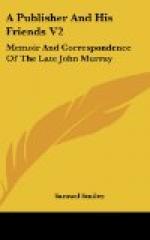Mr. Hanson to John Murray.
November 23, 1815.
“Mr. Hanson’s compliments to Mr. Murray. He has seen Lord Byron, and his Lordship has no objection to his Library being taken at a valuation. Mr. Hanson submits to Mr. Murray whether it would not be best to name one respectable bookseller to set a value on them. In the meantime, Mr. Hanson has written to Messrs. Crook & Armstrong, in whose hands the books now are, not to proceed further in the sale.”
On December 28, 1815, Mr. Murray received the following valuation:
“Mr. Cochrane presents respectful compliments to Mr. Murray, and begs to inform him that upon carefully inspecting the books in Skinner Street, he judges the fair value of them to be L450.”
Mr. Murray sent Lord Byron a bill of L500 for the books as a temporary accommodation. But the books were traced and attached by the sheriff. On March 6, 1816, Lord Byron wrote to Murray:
“I send to you to-day for this reason: the books you purchased are again seized, and, as matters stand, had much better be sold at once by public auction. I wish to see you to-morrow to return your bill for them, which, thank Heaven, is neither due nor paid. That part, so far as you are concerned, being settled (which it can be, and shall be, when I see you tomorrow), I have no further delicacy about the matter. This is about the tenth execution in as many months; so I am pretty well hardened; but it is fit I should pay the forfeit of my forefathers’ extravagance as well as my own; and whatever my faults may be, I suppose they will be pretty well expiated in time—or eternity.”
A letter was next received by Mr. Murray’s solicitor, Mr. Turner, from Mr. Gunn, to the following effect:
Mr. Gunn to Mr. Turner.
March 16, 1816.
Sir,
Mr. Constable, the plaintiff’s attorney, has written to say he will indemnify the sheriff to sell the books under the execution; as such, we must decline taking your indemnity.
The result was, that Lord Byron, on March 22, paid to Crook & Armstrong L231 15_s_., “being the amount of three levies, poundage, and expenses,” and also L25 13_s_. 6_d_., the amount of Crook & Armstrong’s account. Crook & Armstrong settled with Levy, the Jew, who had lent Byron money; and also with the officer, who had been in possession twenty-three days, at 5_s_. a day. The books were afterwards sold by Mr. Evans at his house, 26, Pall Mall, on April 5, 1816, and the following day. The catalogue describes them as “A collection of books, late the property of a nobleman, about to leave England on a tour.”
Mr. Murray was present at the sale, and bought a selection of books for Mrs. Leigh, for Mr. Rogers, and for Mr. J.C. Hobhouse, as well as for himself. He bought the large screen, with the portraits of actors and pugilists, which is still at Albemarle Street. There was also a silver cup and cover, nearly thirty ounces in weight, elegantly chased. These articles realised L723 12_s_. 6_d_., and after charging the costs, commission, and Excise duty, against the sale of the books, the balance was handed over to Lord Byron.




